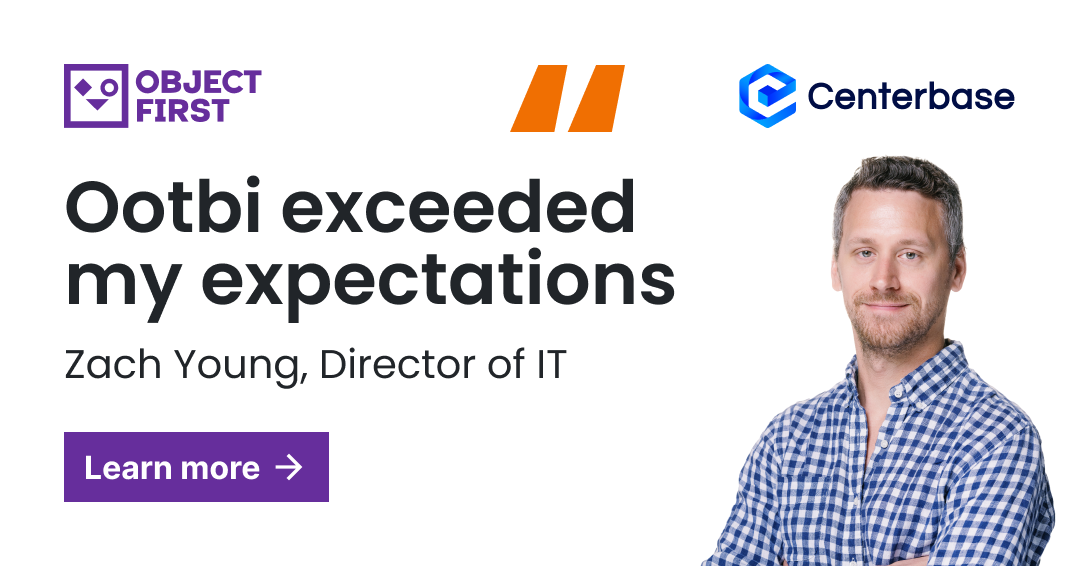Enterprise Backup Solutions: The Definitive Guide
How could an enterprise backup solution have saved a movie?
In the 1990s, a US animation production studio lost nearly all the footage for a movie and failed to recover it from backups.
A crew member sounded the alarm when he saw files vanish in real time. The studio powered down the systems and attempted recovery, but the backups were corrupted. No one had thought to test them.
A US production studio lost film data and couldn’t recover from backups. An enterprise backup solution with automated testing would have saved them the trouble.
The disruption was allegedly caused by a root user’s misguided command. But data failures can happen for various reasons. A natural disaster, a hardware failure, or a ransomware attack are all recipes for shutdowns with a side order of data loss.
An enterprise backup solution works as an antidote against data loss, but only as long as it fits a given business case. In this article, you'll learn what enterprise backup solutions are and why they matter. You'll also find a checklist of essential features to look for when researching these solutions yourself.
What Is an Enterprise Backup Solution?
An enterprise backup solution is a stand-alone, self-sufficient, and robust backup and recovery system. It keeps an organization’s data intact by restoring it automatically after corruption, deletion, malicious encryption, or other unexpected disruptions.
Enterprise backup solutions must integrate software and hardware for optimal performance, timely backups, and prompt recovery.
For optimal performance, enterprise backup solutions must ensure close integration between software and hardware. Such compatibility guarantees timely backups and prompt recovery; however, you must also consider the size of your organization and how it affects the choice of the right solution.
How Should Organizations Approach Enterprise Backup Solutions?
An organization’s size is a key determinant in choosing an enterprise backup solution.
- Small—to mid-size enterprises often encounter issues with insufficient storage. They should focus on backup scalability.
- Conversely, large organizations enjoy ample storage, but it's spread across multiple locations and, therefore, more vulnerable to attacks. For this reason, they need solutions that support the 3-2-1 backup rule.
Small to mid-size organizations need scalable backup solutions to adapt to data growth. Large enterprises need solutions with the 3-2-1 backup rule to better protect multi-site storage targets.
Table 1 will help you navigate and solve the most likely data management challenge based on your organization’s size.
| What’s your organization’s size? | A large enterprise with various teams across multiple locations | A small to mid-size organization (SMB) |
| What’s your most likely challenge? | Data sprawl — you store data in so many locations that tracking and organizing it is difficult. | Data deluge — you process more data than you can physically store. |
| Data silos — your applications do not always share information with each other, raising concerns about the integrity and completeness of backups. | ||
| What’s the top consideration? | You need an enterprise backup solution supporting the 3-2-1 backup rule to protect data in multiple locations. | You need a scalable enterprise backup solution that will accommodate data in one of two ways:
|
Table 1: Data management challenges and solutions according to organization size
What Are the Reasons For Using Enterprise Backup Solutions?
The security assurance afforded by enterprise backup solutions cascades to other areas, strengthening business continuity, regulation compliance, customer loyalty, employee productivity, and other business aspects.
The following is a list of reasons that make enterprise backup solutions indispensable in fostering safe, efficient, and reliable business environments:
- Unbeatable ransomware protection. In 2023, 85% of organizations experienced a ransomware attack. Shockingly, less than half of the affected data was recovered. Enterprise backup solutions prevent ransomware using immutability, access control, and other security measures such as in-flight and at-rest encryption.
- Uncompromised data integrity. Even a few percent of corruption can render an entire database unusable. Enterprise backup solutions uphold data integrity through regular testing, making sure backup copies are always error-free.
- Uninterrupted business continuity. The Ponemon Institute reports that a minute of downtime costs an average of $9,000. Enterprise backup solutions shorten or even eliminate downtime with disaster recovery that restores operations quickly and efficiently.
- Continuous regulation compliance. Personal data protection regulations, such as GDPR in Europe, COPPA in the US, and others, require organizations to protect their users’ data from tampering or corruption. Other types of data regulations cover specific industries, e.g., health and finance. Enterprise backup solutions facilitate regulation compliance by implementing required guardrails, such as immutability or encryption.
- Improved user experience. It is harder to win back a customer's trust than to gain it. Service interruptions and security incidents put customer loyalty to the test and jeopardize an organization’s reputation. Enterprise backup solutions make businesses more reliable to users.
- Consistent productivity. Employees cannot perform when systems are down or compromised. Enterprise backup solutions sustain worker productivity by ensuring uptime and continued access to essential tools.
- Peace of mind. Last but not least, enterprise backup solutions promote a sense of security throughout an organization. C-level executives, management, admins, engineers, and back office workers thrive in the comfort of knowing they’re protected by the right enterprise backup solution.
How to Choose an Enterprise Backup Solution?
A rule of thumb when picking an enterprise backup solution is to look for software and hardware that complement each other. Ideally, they should come from the same vendor or be explicitly designed to cooperate. Such coordination boosts security, performance, and ease of management.
When picking an enterprise backup solution, look for software and hardware from the same vendor or explicitly designed for each other. This will boost security, performance, and ease of management.
Software and Hardware Integration
Veeam and Ootbi are excellent examples of how software and hardware can combine seamlessly into one enterprise backup solution.
Veeam is the world’s leading backup management software. Ootbi, which stands for out-of-the-box immutability, is a backup storage target created by Veeam founders with native integration with Veeam. Together, they provide unbeatable data protection and disaster recovery.
Hailing from the same founders, Veeam and Ootbi offer a full, mutually compatible enterprise backup solution, with Veeam as the software layer and Ootbi as the storage target.
Software Layer: Key Features
For your convenience and reference, we have curated a list of key features to look for in the software layer of an enterprise backup solution.
| Feature | Description | Veeam |
|---|---|---|
| Multiple backup types | Support for more than one backup type—ideally, full and incremental (see FAQ for details). | ✅ Full and incremental backups. |
| Multiple backup targets | Using more than one backup target for the same data increases an organization’s security posture by creating redundancies in line with the 3-2-1 backup rule. | ✅ Support for cloud, on-prem, and hybrid, allowing for the implementation of the 3-2-1 backup rule. |
| Long-term data retention | Business needs, or regulatory constraints may require specific retention periods for given datasets. | ✅ Grandfather-father-son (GFS) long-term retention policy with yearly, monthly, and weekly retention flags. |
| Immutability and encryption | Encryption prevents data tampering, exfiltration, and interception; immutability thwarts ransomware. | ✅ End-to-end encryption and immutability for all storage options. |
| Fast and flexible recovery | Granular recovery options save time and resources when a full backup would be unnecessary. | ✅ Industry-leading recovery speeds; custom restoration of individual files, folders, or entire systems without unnecessary data restoration. |
| Automated testing | Testing verifies backup integrity and benchmarks disaster recovery efficiency. | ✅ Fully automated, zero-impact DR testing that is scheduled or on-demand. |
| Built-in compliance tools | Compliance with security best practices further fortifies an organization’s security posture. | ✅ Security & Compliance Analyzer to check security best practices. |
| Threat detection | Real-time monitoring and analysis strengthen security and neutralize threats before they can do damage. | ✅ AI-powered threat detection and proactive threat hunting. |
| Multiple integrations | Integrations increase software's versatility and use cases, allowing businesses to adapt it to their needs. | ✅ Primary storage integrations |
Hardware Layer: Key Features
Once you’ve decided on the software, it’s time to look for the hardware. Use the list below to vet contenders based on key features.
| Feature | Description | Ootbi |
|---|---|---|
| Immutability | Immutability keeps backup data from being altered once written—a must-have when 93% of all ransomware attacks target backups. | ✅ Out-of-the-box immutable with S3 Object Lock and zero access to root. |
| Scalability | Scaling accommodates the growing amount of data by upgrading resources (vertical scaling) or adding nodes (linear scaling) | ✅ Scales within minutes by adding a node. |
| Ingest speed | Higher ingest speeds enable frequent backups, decreasing RPO (Recovery Point Objective) and minimizing data loss in an incident. | ✅ Ingest speed up to 4GB/s. |
| Disaster recovery | Disaster recovery uses virtual machines (VMs) to run failed workloads directly from backups. Faster recovery decreases RTO (Recovery Time Objective), bringing systems back online with minimal interruption. | ✅ Supports Instant Recovery tested with up to 80 VMs on a 4-node cluster. |
| Load balancing | Load balancing distributes workloads evenly to ensure optimal performance when handling backups from parallel sources or relying on linear scaling. | ✅ Automated load balancing between nodes. |
| Encryption | In-flight encryption prevents interception of data in transit. | ✅ HTTPS encryption of all network traffic between Veeam and Ootbi.Ease of use |
| Ease of use | Ease of operation and management reduces the risk of human error, which is essential in business-critical areas such as backup and disaster recovery. | ✅ Zero expertise required configuration and an intuitive WebUI. |
| Support and documentation | Continuous support and up-to-date documentation ensure smooth management and operation despite potential hurdles. | ✅ 24/7 support and complete online documentation. |
How Can Ootbi Support an Enterprise Backup Solution?
Ransomware-proof and immutable out-of-the-box, Ootbi supports enterprise backup solutions as the hardware layer and is designed to work with Veeam, the top-tier data backup and recovery software.
“Ootbi is much faster than our other backup storage. We can decrease our RPO from 8 to 4 hours. In time, we should be able to lower RTO and RPO even further.”
Zach Young
Director of Information Technology, Centerbase
It requires no technical expertise to set up, boasts backup speeds of up to 4GB/s, and enables Instant Recovery with 80 VMs running simultaneously.
Book a live demo and see how Ootbi by Object First delivers secure, simple, and powerful backup storage for Veeam customers.
FAQ
What Are the Main Types of Enterprise Data Backups?
Enterprise backup solutions offer full backups, incremental backups, differential backups, or a combination.
- Full backups ingest all the production data.
- Incremental backups only ingest data that has changed since the last backup.
- Differential backups only ingest data that has changed since the last full backup.
Note: Differential backups are considered a relic of the times when backups relied on tapes rather than disks. That’s why disk-centered backup solutions, including Veeam, tend to favor incremental backups instead.
Our guide, Data Backup: Definitions, Options, Types, and Solutions, will help you gain a deeper understanding of the backup types.
Which Storage Solution Is Better, Cloud or On-Premise?
Choosing the right type of storage will depend on your business requirements.
- Cloud storage solutions are more affordable but compromise on control and reliability. The dependence on third-party providers means that your data is not entirely in your grasp, and its availability relies on the network connection and vendor performance.
- On-prem storage offers the best security and control, ensuring availability regardless of network outages or vendor downtime. However, it is more costly and management-intensive than its cloud counterpart.


